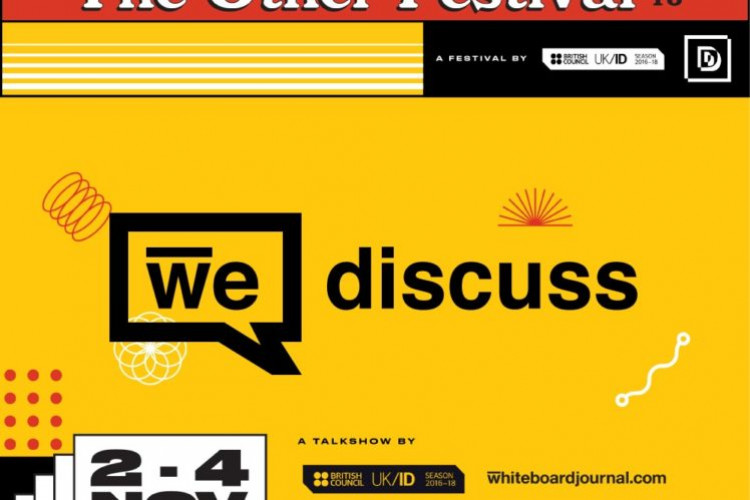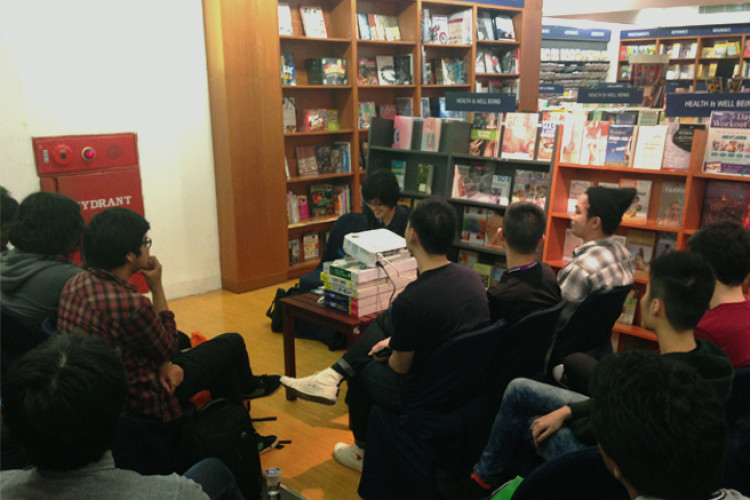
We Discuss is Back!
We Discuss akan kembali untuk edisi terbaru!

We Discuss akan kembali untuk edisi terbaru!

Here is a list of recommended reads for next week’s Fantastic Film Feast discussion: Southeast Asian Films with Apichatpong Weerasethakul “For me, story is secondary to feelings, and when you try to explain so much you are losing the beauty and locality. When you travel abroad there will be many things you cannot understand. I don’t need to explain that, it is the beauty of differences, accept it for what it is. Film is not a textbook; it is a different form of expression. If you really want to reach a wide international audience, then what kind audience? Because there are so many. Do you want to be a textbook and make everything clear? It depends. For me, I prefer to make the film as much as I want to understand.” Film Craftmanship with Mouly Surya “In my opinion, even though it won’t apply to everyone, I am not talking about feeding the students with bulky theoretical thoughts but there are conventions in filmmaking that people should understand before they start filmmaking. A degree of knowledge has to be learnt to understand a film within the first five minutes of its inception. Think of it as a language. I see film as a language to communicate. Filmmakers need to understand this visual language. I don’t believe in an instinctive filmmaker, moreover I don’t believe in talent. There is basic knowledge about filmmaking that people need to acquire if they are truly interested in their craft.” The Persisting Vision: Reading the Language of Cinema by Martin Scorcese “Now we take reading and writing for granted but the same kinds of questions are coming up around moving images: Are they harming us? Are they causing us to abandon written language? We’re face to face with images all the time in a way that we never have been before. And that’s why I believe we need to stress visual literacy in our schools. Young people need to understand that not all images are there to be consumed like fast food and then forgotten – we need to educate them to understand the difference between moving images that engage their humanity and their intelligence, and moving images that are just selling them something.” Film as Film by Malcolm Thorndike Nicholson “I do not mean to suggest that the critics above are not thoughtful or knowledgeable enough about film as an art. Yet the aspects of filmmaking these critics are ignoring are hardly peripheral. They are as crucial to the effect of a movie as brushstrokes and pigment are to a painting. And remembering the question we began with – in the digital age what is left for a critic to supply? – it makes their absence all the more relevant. It doesn’t follow that critics should suddenly ignore narrative and character development and spend 500 words analyzing camera technique; that would be fatally boring, as well as alienating. But reviewing films as if they are stories that merely happen to be told using a camera can often miss the point. Most importantly, the sort of writing we currently lack can, and has, been done successfully before.” Towards a New Film Criticism by Willie Osterweil “Entertainment reinforces the narcissistic myth of the consumer as master of his own experience: In the movies, a protagonist always wins by making the right choices or loses by making the wrong ones. The important thing isn’t success or failure, tragedy or comedy, it’s the protagonist’s individual responsibility: If he’s crushed, it’s because he picked a fight with an enemy too powerful to overcome. If he finds love, success, and happiness, it’s because he did the right things starting from a level playing field where anyone can succeed. But the individual’s actions provide cover for the systematic processes of alienation and exploitation. By focusing on the film-historical context—the aesthetic idiosyncrasies of an individual film or its connections to other films by genre, crew, or cast—film criticism fails to see the intentions and desires of the film industry, the only active subject in major cinema. In doing so, film criticism colludes with the entertainment industry’s massive project of commodifying experience. By treating entertainment products as a mirror of social experience, film criticism legitimates capitalist alienation while cheapening the possibilities of art. The point is not, however, to become silent. A new film criticism must emerge: By evaluating a film’s methods of production, its place in the film current, and its similarities to concurrently released films on top of its individual contents, film criticism can understand the multiplex’s true ideological effects and reveal new avenues of cinematic pleasure.” Tuesday, March 25, 2014 7–9 pm Kinokuniya Plaza Senayan (near the language section) Jl. Asia Afrika 8 Sogo Plaza Senayan Lt. 5 Jakarta 10270 Please look out for more #WeDiscuss updates on our Facebook page and Twitter account! If you’d like to share your opinions, or if you have friends who’d like to share theirs, sign up via e-mail with the subject title “We Discuss” at ! If you have comments or questions, tweet us @wjournal.

Film is surely no one-dimensional topic. There are so many aspects to it, but in order for us to be able to discuss it within two hours, we have to select only several parts of the field. In an attempt to spice things up a little bit, and perhaps look at film from another perspective, we are going to connect it with terms associated with food. Preparing and Cooking - In “The Persisting Vision: Reading the Language of Film,” Martin Scorcese highlights the three main elements, or “ingredients” in films: and. - Light: “Light is at the beginning of cinema, of course. It’s fundamental – because cinema is created with light, and it’s still best seen projected in dark rooms, where it’s the only source of light.” - Movement: As opposed to photographs (still images), film involves motion, but not only of the subjects within the film – there is also the movement of time. - Time: The time setting (or settings in the film) and “real” time (of the audience). Film allows us to experience several time periods at a time. - Additional “spices” (e.g. soundtracks, special effects) - And then there is the question of how to mix the ingredients and cook it well. What are the standards? Who sets the standards – the chef or the diner? - What is the significance of appetizers or complementary snacks – teasers and trailers? Presentation, Consumption and Digestion - To what extent can a film succeed without including all of the vital “ingredients? Perhaps it is possible to consider the analogy of a restaurant, with which one could also depend on the ambience/atmosphere – the “mood” – of the film rather than the plot. - “As in the case of many great films, maybe all of them, we don’t keep going back for the plot. is a matter of mood as much as it’s a matter of storytelling,” wrote Scorcese. He suggests that while a good plot might make a great impression, it is the mood that has the power to make us want to see a particular film again. But do you think it is possible for the mood to be at the center of a film? - In our interview with the Thai independent director, Apichatpong Weerasethakul, he states that for him, “Story is secondary to feelings, and when you try to explain so much you are losing the beauty and locality.” He also noted that it’s not possible to appeal to everyone in the “international audience” as it is so diverse. Like food, it is perhaps difficult to create a “universal taste” that ignores the existence of the long histories of cultures. - Do you think that the “mood” of a film can cross national borders? Can it solve the problem language barriers (despite the use of subtitles) and culturally specific gestures? Or if the mood is not enough, how about the visual presentation of the film? Do you think that aesthetics (cinematography, set and costume design, etc.) can draw more people to a particular film? - Please also keep in mind that there is also the choice of a light meal (in terms of content, or the "short film") and a heavy meal (again, in terms of content and "feature film"). The Director, The Actor, The Audience, The Critic - “We were living through the emotional truths on the screen, often in coded form, which these films from the 1940s and 1950s sometimes expressed in small things: gestures, glances, reactions between the characters, light, shadow. These were things that we normally couldn’t discuss or wouldn’t discuss or even acknowledge in our lives,” wrote Scorcese. Do you think that a certain degree of “literacy” is necessary to pick up the subtitles of the cinematic language Scorcese suggests? - Perhaps literacy is in an important tool for the audience. Appreciation can be emotional or based on instincts, but if one is able to pinpoint the exact reason as to why they appreciate something – that is, if they understand and are able to explain one’s reasons for liking a certain film – do you think that the impression will last longer? - In your opinion, what are the most important elements in the relationship between the director, the actor, the audience, and the critic? What do you think can cause conflicts among them? Tuesday, March 25, 2014 7—9 pm Kinokuniya Plaza Senayan Please look out for more #WeDiscuss updates on our Facebook page and Twitter account! If you’d like to share your opinions, or if you have friends who’d like to share theirs, sign up via e-mail with the subject title “We Discuss” at ! If you have comments or questions, tweet us @wjournal.

Despite the pervasiveness of music in our daily lives, last night's discussion proved that there music is made up of multiple layers. In order to understand music, knowing what or who we enjoy listening to is not enough. Below are some of the points that were brought up during last night's discussion: - Because music is so difficult to describe, the most important thing is often our reactions. Those reactions are the most crucial part of music. - The musical experience – that is, our listening habits – are mood-based. It is usually the case that we look for songs that would intensify our emotions at the time. Music, in a way, amplifies and perhaps even justifies our feelings. - Instrumental music vs. songs: both songs evoke different feelings and reactions. The former often conjures impressions whereas the latter produce a clear image/narration. - On the social significance of music: we typically listen to music that we can relate to. Music does not only affect a person on an individual level, but also at a more collective and cultural level. , for instance, usually includes lyrics that tell the story of a person’s life in a given socio-economic context. - Stereotypes affect how we listen to music, and whose music we listen to. - Our appreciation towards music is often related to time. This is perhaps why the idea of a “generation” is very strong in the context of music. People who have gone through similar social experiences are more likely to relate to the music produced during a particular era. - DJing is both active and passive since the DJ plays as s/he listens to the music. - On sampling and originality: sampling is not a second-rate pursuit in music as it involves the active selection of existing material to create something new. - It is difficult to separate music and the creators (though sometimes it depends on the genre). - Music is first and foremost a form of entertainment; the message can come later (once the listener has familiarized his/herself with the music). - Music is intrusive. It is not like text, a medium that allows people to choose their involvement with it. - In live performances, musicians can get direct feedback from the audience. It is possible to have an interaction. - In addition to the romance associated with the physicality of vinyl records, they are useful for documentary purposes whereas digital files that are distributed through the Internet increase the accessibility of music (by an audience that will most likely consists of diverse cultural and socio-economic backgrounds). In short, each medium or “vessel” has its own purpose. One can’t simply say that one medium is more superior to the other. - Technological advancement opens doors to new ways of understanding and appreciating music (e.g. smartphone apps that help users experience a song in an innovative way). And the more our old and current mindsets adjust to the development of technology, the more ways we’ll create to make and share music. Your feedback would be greatly appreciated, so please feel free to tweet us @wjournal or send us an e-mail to with the subject title “We Discuss #8.” We would like to thank those who came and contributed to the discussion. We hope to see you again at next month’s session! Look out for announcements and related updates on next discussion. Check our website, Facebook page, as well as our Twitter and Instagram accounts!

Here's our list of recommended reading material for next week's "Speaking of Tunes" We Discuss session. Listening and Collecting with Fadli Aat “For me, vinyl records are very primitive – it’s very analog. It’s like those pianos in cowboy saloons or music boxes, the player read this physical groove on the record. Also, the sound vinyl records produce… compared to CDs they sounds much better and much more honest, in my opinion. They are both mixed and mastered, but I don’t know, it just is much more honest. The physicality of the groove has a lot to do with it. CDs are digital, so CD players read them without that physicality. The artwork on records has a lot to do with it as well. There are so many things you get when you buy that one record. The music and the musical quality, then you have the large and beautiful artwork as well.” Rhythm of the Archipelago with David Tarigan “It’s difficult to put into words. I grew up in an era before music can be ripped digitally. I started buying CD, cassettes and vinyl back when I was in primary school. The physical format of music has always played a big part for me. I love old music, and I wanted to experience it the way it was first released. It is an artifact, a piece of history. That’s why until this day I have never purchased a single re-issue. No matter how bad the quality of the record is, it is a part of the experience. You don’t just listen to a song. When you get you hands on the album, you open the sleeve, read it, touch and even smell it. It is sort of a ritual, a way of worshipping your favorite band. Sometimes people buy an album based on its cover, and if the music is as good as the cover, the experience will be even more rewarding. In the end it really depends on the individual. I always tend to leave some room for the imagination when it comes to my interaction with music. I like to interpret songs and create personal images of the music. The physicality of the record and the ritual of listening is the foundation that allows me to create my personal opinion of the music.” The Lint of Material by Sven Birkerts “The shift from vinyl recordings to CDs was significant, psychologically as well as technologically. While the shiny silver disc physically echoed its predecessor in a few obvious ways – was still a flat circular disc with a hole in the center – the differences were many. They were also symbolic. Where the album had two sides, needing to be ‘flipped’ for full hearing, thereby underscoring its temporality and the fact that its contents were arranged, the silver disc compressed its material on a single side. Tracks were no longer demarcated for the eye, so that all one saw was an elegant shimmering surface. And to make it operational – to play it – the listener had to slide it into the player. It disappeared, and the process whereby the information coded onto the disc became sound was (to me) conjectural: something to do with a laser scanning digits. To change cuts – assuming one was listening to standard fare – no longer required moving the tonearm to the wanted place. A quick touch of the button sufficed. If my explanation of how a needle extracted sound from vinyl was rudimentary and approximate, at least it took into account the basic elements and the everyday physics involved. I can’t tell you how a laser translates digital information; indeed, I cannot tell you how information is rendered into digital form, beyond invoking something about binary code – sequences of ones and zeros that are ‘read.’” Beethoven and the Quality of Courage by Daniel Barenboim “Music means different things to different people and sometimes even different things to the same person at different moments of his life. It might be poetic, philosophical, sensual, or mathematical, but in any case it must, in my view, have something to do with the soul of the human being. Hence it is metaphysical; but the means of expression is purely and exclusively physical: sound. I believe it is precisely this permanent coexistence of metaphysical message through physical means that is the strength of music. It is also the reason why when we try to describe music with words, all we can do is articulate our reactions to it, and not grasp music itself.” “The Grain of the Voice” in by Roland Barthes “The (if the transposition be allowed) covers all the phenomena, all the features which belong to the structure of the language being sung, the rules of the genre, the coded form of the melisma, the composer’s idiolect, the style of the interpretation: in short, everything in the performance which is in the service of communication, representation, expression, everything which it is customary to talk about, which forms the tissue of cultural values (the matter of acknowledged tastes, of fashions, of critical commentaries), which takes its bearing directly on the ideological alibis of a period (‘subjectivity,’ ‘expressivity,’ ‘dramaticism,’ ‘personality’ of the artist). The is the volume of the singing and speaking voice, the space where significations germinate ‘from within language and in its very materiality’; it forms a signifying play having nothing to do with communication, representation (of feelings), expression; it is that apex (or that depth) of production where the melody really works at the language – not at what it says, but the voluptuousness of its sound-signifiers, of its letters – where melody explores how the language works and identifies with that work. It is, in a very simple word but which must be taken seriously, the of the language.” Tuesday, February 25, 2014 7—9 pm Kinokuniya Plaza Senayan (near the language section) Jl. Asia Afrika 8 Sogo Plaza Senayan Lt. 5 Jakarta 10270 Look out for updates on our Facebook page and Twitter account! If you’d like to share your opinions, or if you have friends who’d like to share theirs, please sign up via e-mail with the subject title “We Discuss” at ! If you have comments or questions, tweet us .

How do we talk about music? Some might say that there’s no need to talk about it, as music has the power to speak for itself. While it is highly possible for the essence of music to be reduced by language, it is also possible for it to be enhanced through the use of language. By exploring music via other mediums (text, visuals, etc.), we are creating alternative forms in which it can exist. In this discussion, let’s consider the many options through which we can gain a better understanding of music. - In the essay entitled “Beethoven and the Quality of Courage,” Daniel Barenboim says that though music can mean a lot of different things to different people, its core lies in its connection with “the soul of the human being.” He then goes on to say that it is “metaphysical” despite its means of expression being “purely and exclusively physical” (i.e. that it is expressed in the form of sound). In his opinion, these qualities are what make music difficult to describe with words, which is why “all we can do is articulate our reactions to it, and not grasp the music itself.” - Roland Barthes highlights another problem with musical description in his essay, “The Grain of the Voice.” He says that in music criticism, “a work (or its performance) is only ever translated into the poorest of linguistic categories: the adjective.” - Barthes brings up another point that could further complicate the act of describing music in “Music Practica.” According to him, there are two types of music: 1.) the music one listens to, and 2.) the music one plays. Do you think that there are more categories? And do you think that each category needs its own “language” in order to be effectively described? - (communication via linguistic means) vs. (communication via the volume of one’s voice/instruments – i.e. diction – and gestures) - “Concurrently, passive, receptive music, sound music, is become music (that of the concert, festival, record, radio): playing has ceased to exist; musical activity is no longer manual, muscular, kneadingly physical, but merely liquid, effusive, ‘lubrificating,’ to take up a word of Balzac,” wrote Barthes in Musica Practica. His ideas regarding the consumptive approach towards music still rings true today, even though the same approach has also empowered many to make their own music. Here, Barthes compares and contrasts the two musics mentioned in the previous section. What are your thoughts on his opinion on “passive music”? - The digital age has made music very accessible for an incredibly wide audience. We forget that long before the invasion of the mp3, there were physical “vessels” – vinyls, cassettes, CDs – that allowed us to listen to our very musicians in private. Please look out for more #WeDiscuss updates on our Facebook page and Twitter account! If you’d like to share your opinions, or if you have friends who’d like to share theirs, sign up via e-mail with the subject title “We Discuss” at ! If you have comments or questions, tweet us @wjournal.
